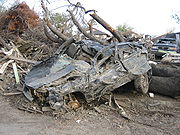
New Orleans diaspora
Encyclopedia

Diaspora
A diaspora is "the movement, migration, or scattering of people away from an established or ancestral homeland" or "people dispersed by whatever cause to more than one location", or "people settled far from their ancestral homelands".The word has come to refer to historical mass-dispersions of...
refers to the population evacuated or forced to flee from New Orleans, Louisiana
New Orleans, Louisiana
New Orleans is a major United States port and the largest city and metropolitan area in the state of Louisiana. The New Orleans metropolitan area has a population of 1,235,650 as of 2009, the 46th largest in the USA. The New Orleans – Metairie – Bogalusa combined statistical area has a population...
, by the effects of Hurricane Katrina in the late summer of 2005.
As of July 1, 2008, New Orleans had a population of 311,853, a decrease in population from the 445,000 residents of the city prior to Hurricane Katrina
Hurricane Katrina
Hurricane Katrina of the 2005 Atlantic hurricane season was a powerful Atlantic hurricane. It is the costliest natural disaster, as well as one of the five deadliest hurricanes, in the history of the United States. Among recorded Atlantic hurricanes, it was the sixth strongest overall...
.
Pre-Katrina decrease in population
Prior to Hurricane Katrina, New Orleans had experienced a decrease in population of 18% (109,000 residents) between 1970 and 2000, and which fell by a further 6% (30,000 residents) from2000 to 2005.
Diaspora destinations
In the initial period following Hurricane Katrina, there were several useful sources of data about where displaced residents from New Orleans were living. In particular, information on the location of evacuees was available from change-of-address forms filed with the U.S. Postal Service and from registrations with the Federal Emergency Management AgencyFederal Emergency Management Agency
The Federal Emergency Management Agency is an agency of the United States Department of Homeland Security, initially created by Presidential Reorganization Plan No. 1 of 1978 and implemented by two Executive Orders...
(FEMA) for aid. Analyses of these data showed that nearly 15% of evacuees from New Orleans relocated to distant cities in the East Coast, Midwest, and West Coast. The main destinations for displaced residents were suburban New Orleans, Houston, Dallas, Atlanta, and Baton Rouge.
Demographics
As of 2008, just over half of the city’s adult residents (56 percent) were African AmericanAfrican American
African Americans are citizens or residents of the United States who have at least partial ancestry from any of the native populations of Sub-Saharan Africa and are the direct descendants of enslaved Africans within the boundaries of the present United States...
, roughly one in three (35 percent) were Caucasian
White American
White Americans are people of the United States who are considered or consider themselves White. The United States Census Bureau defines White people as those "having origins in any of the original peoples of Europe, the Middle East, or North Africa...
, and 5 percent were Hispanic
Hispanic and Latino Americans
Hispanic or Latino Americans are Americans with origins in the Hispanic countries of Latin America or in Spain, and in general all persons in the United States who self-identify as Hispanic or Latino.1990 Census of Population and Housing: A self-designated classification for people whose origins...
. This is roughly equivalent to the shape of the population in a 2006 survey, fielded one year after Katrina. It is also fairly similar to the city’s pre-storm distribution as measured by the Census Bureau’s 2005 American Community Survey (ACS), which found that the adult population was 60 percent African American and 32 percent Caucasian.
Housing
Housing issues, particularly for the poor, has been a contentious issue. In 2002, the United States Department of Housing and Urban Development (HUD) took over the Housing Authority of New Orleans (HANO), and planned shortly thereafter to redevelop half of the city's public housing complexes, which plan was instituted with urgency after Katrina struck the city. The plan has been met with controversy, with protests after the government decided to replace 4,500 units of housing with a mixed-use development that has 744 public housing units in C.J. Peete, B.W. Cooper, Lafitte and St. Bernard public housing projects.In May 2009, FEMA announced an end to its temporary housing program it started in the aftermath of Katrina, but presented with the more than 3,400 people still living in FEMA trailers in Louisiana and Mississippi who faced eviction, offered hurricane victims on the Gulf Coast still living in government-supplied trailers to buy their temporary homes for as little as $1.
In the meantime, rent has spiked an average of 40% since the storm in the city, with the small rental program instituted after the disastor having been ineffective in assisting small holding landlords to rebuild and improve properties previously inhabited by renters.

